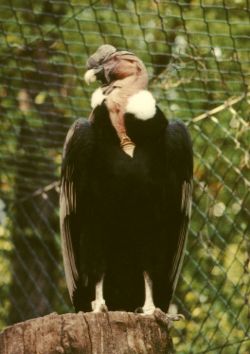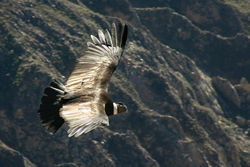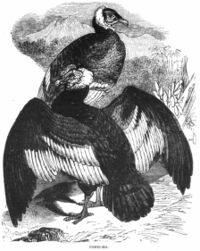Andean Condor
Conservation status Near threatened |

Condor in Nuremburg Zoo
|
|
Scientific classification |
| Kingdom: |
Animalia
|
| Phylum: |
Chordata
|
| Class: |
Aves
|
| Order: |
Ciconiiformes
|
| Family: |
New_World_vulture.html
|
| Genus: |
Vultur
Lesson, 1842 |
| Species: |
V. gryphus
|
|
|
Binomial name |
Vultur gryphus
(Linnaeus,
1758) |
|
Synonyms |
- Vultur fossilis
Moreno & Mercerat,
1891
- Vultur patruus
Lönnberg, 1902
- Vultur pratruus Emslie,
1988 (lapsus)
|
The Andean Condor, Vultur gryphus, is a
species of bird in one of the
vulture families. It is in many regards the largest
flying land bird in the Western Hemisphere and is the
heaviest, but not the lengthiest, member of the order
Ciconiiformes.
This
condor inhabits the
Andes mountains. Although it is primarily a scavenger,
feeding on carrion, this species belongs to the New World
vulture family Cathartidae, related to storks and not
closely related to Old World vultures, which are in the
family Accipitridae along with
hawks,
eagles and
kites.
Appearance
Although about 5 cm shorter (beak to tail) on average
than the
California Condor, the Andean Condor is undoubtedly
larger in wingspan: Ferguson-Lees gives 274–310 cm (108–122
in). It is also heavier: up to 11–15 kg (24–33 lb) for males
and 7.5–11 kg (16–24 lb) for females. Measurements are
usually taken from specimens reared in captivity.
The adult
plumage is of a uniform black, with the exception of a
frill of white feathers nearly surrounding the base of the
neck and, especially in the male, large patches or bands of
white on the wings which do not appear until the completion
of the first moulting. As an adaptation for hygiene, the
head and neck have few feathers, exposing the skin to the
sterilizing effects of dehydration and ultraviolet light at
high altitudes, and are meticulously kept clean by the bird.
The head is much flattened above. In the male it is crowned
with a caruncle or comb, while the skin of the neck in the
male lies in folds, forming a wattle. The skin of the head
and neck is capable of flushing noticeably in response to
emotional state, which serves to communicate between
individuals.
The middle toe is greatly elongated, and the hinder one
but slightly developed, while the talons of all the toes are
comparatively straight and blunt. The feet are thus more
adapted to walking as in their relatives the storks, and of
little use as weapons or organs of prehension as in birds of
prey and Old World vultures. The female, contrary to the
usual rule among
birds of prey, is smaller than the male.

An Andean condor soars over southern
Peru's Colca Canyon
Behavior
Sexual maturity and breeding behavior do not appear in
the condor until 5 or 6 years of age. They may live for 50
years or more, and mate for life. The Andean condor prefers
roosting and breeding at elevations of 3,000 to 5,000 m
(10,000–16,000 ft). There on inaccessible ledges of rock,
its nest consisting merely of a few sticks placed around the
eggs, it deposits one or two bluish-white eggs, weighing
about 10 ounces (280 g) and from 3 to 4 inches (75 to 100
mm) in length, during the months of February and March every
second year. The egg hatches after 54–58 days of incubation
by both parents. If the chick or egg is lost or removed,
another egg is laid to take its place. Researchers and
breeders take advantage of this behavior to double the
reproductive rate by taking the first egg away for
hand-rearing, causing the parents to lay a second egg which
they are generally allowed to raise.
The young are covered with a grayish down until almost as
large as their parents. They are able to fly after six
months, but continue to roost and hunt with their parents
until age two, when they are displaced by a new clutch.
There is a well developed social structure within large
groups of condors, with competition to determine a 'pecking
order' by body language, competitive play behavior, and a
wide variety of vocalizations, even though the condor has no
voice box.
On wing the movements of the condor, as it wheels in
majestic circles, are remarkably graceful. The lack of a
large sternum to anchor correspondingly large flight muscles
identifies them physiologically as primarily soarers. The
birds flap their wings on rising from the ground, but after
attaining a moderate elevation they seem to sail on the air.
Charles Darwin commented on having watched them for half
an hour without once observing a flap of their wings. They
prefer to roost on high places from where they can launch
without major wing-flapping effort. Oftentimes, these birds
are seen soaring near rock cliffs, using the heat thermals
to aid them with rising in the air.
Wild condors inhabit large territories, often traveling
250 km (150 miles) a day in search of carrion. They prefer
large carcasses such as deer or cattle which they spot by
looking for other scavengers, who cannot rip through the
tougher hides of these larger animals with the efficiency of
the larger condor. In the wild they are intermittent eaters,
often going for a few days without eating, then gorging
themselves on several pounds at once, sometimes to the point
of being unable to lift off the ground.
Human influence

Andean Condors, depicted in the 1851 Illustrated
London Reading Book
The Andean Condor is the national symbol of Bolivia,
Colombia, Ecuador, Peru, Argentina, and Chile. It plays an
important role in the folklore and mythology of the South
American Andean regions, similar to the role the Bald Eagle
plays in North America. As such, condors are depicted in the
national coats of arms of Colombia, Ecuador, Bolivia, and
Chile, and can also be seen in the state flag of
Ecuador.
One of best known Peruvian songs is
El Cóndor Pasa (The condor passes), composed
by Peruvian musician
Daniel Alomía Robles. The melody attained world fame years
later, in Paul Simon's "If I Could". Tourists can see the
condors flying freely at the Colca Canyon in Peru, which is a natural habitat of the great Andean
Condor.
The Andean Condor is becoming more common in bird shows,
and these large birds can prove very powerful and
aggressive, so a well-trained Andean Condor appearing free
in a public show is an impressive feat.
Systematics and evolution
See
Sibley-Ahlquist taxonomy for a radically different
approach to ciconiiform classification, quite popular in the
late 20th century but is increasingly falling out of favor,
being superseded by more current research.
The Andean Condor is the only accepted species of its
genus, living or extinct. Unlike the California Condor,
which is known from extensive fossil remains and some
additional ones of congeners, the fossil record of the
Andean Condor recovered to date is scant. Some prehistoric
genera of New World vultures seem to be closely related to
Vultur; the Argentine Early to Middle Pliocene Dryornis
pampeanus may actually belong into this genus. Presumed Plio-/Pleistocene
species of South American condors were later recognized to
be not different from the present species, although one
known only from a few rather small bones found in a Pliocene
deposit of Tarija Department, Bolivia, may have been a
smaller palaeosubspecies, V. gryphus patruus (Fisher,
1944).
References
- Fisher, Harvey L. (1944): The skulls of the
Cathartid vultures.
Condor 46: 272-296.
PDF fulltext
External links




